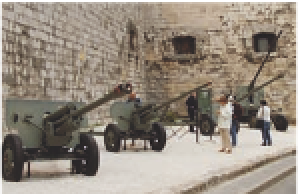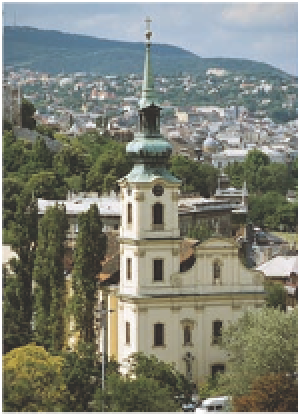Travel Reference
In-Depth Information
&
Tabán
There is little left of Tabán's
original character, as its narrow
streets and run-down bars on the
northern slopes of Gellért Hill
were cleared in 1910 to make
way for scenic terraces, gardens
and Secession buildings. It was
one of the irst areas to be
inhabited in Buda - the Celtic
Eravi had a settlement here from
1000 BC. The Romans later built
a watchtower in the area, and in
the 15th century, the Turks built
the Rác Baths
(see p37)
. In the
17th century, Tabán was home
to Serb refugees, Greeks and
Gypsies. Today, it is a popular
venue for summer concerts,
while in winter, the hillside is
ideal for tobogganing.
d
Map H4
*
Tabán Parish Church
The ominous Citadel on Gellért Hill
%
Citadel
Built to intimidate
Budapest's citizens after the
failed Uprising of 1848-9, the
Citadel was never actually used
for its original purpose - that of
quelling new revolts - as the
Hungarians sought their indepen-
dence by more peaceful means.
Although the country was
granted partial independence
according to the Dual Monarchy
agreement of 1867, Austrian
forces occupied the Citadel until
1897. Today, it hosts a small exhi-
bition and a restaurant
(see p73)
,
and its look-out points offer great
views of the city.
d
Map K6
^
Liberation Monument
This church is all that remains
of Tabán's old district. Topped by
a ine Neo-Baroque tower, it was
built from 1728 to 1736 on the
site of an earlier church that was
converted to a mosque and later
destroyed in the battle to over-
throw the Ottoman Empire.
Inside, is a copy of the 12th-
century carving,
Christ of Tabán
.
Perhaps the most
controversial monument in
Hungary, this imposing cenotaph
towers above the nearby Citadel.
It was originally sculpted by
Zsigmond Kisfaludi Stróbl in 1943
to honour István, son of Admiral
Horthy, who went missing during
an air battle on the Eastern Front
in 1942. However, the battle for
Budapest towards the end of
World War II prevented the stat-
ue's erection, and its purpose
was reassigned by the Red Army
in 1945 to commemorate the
liberation of Budapest by Soviet
forces. The inscription on the
plinth originally paid tribute to
the Red Army, but was changed
in 1989 and now honours all those
who “laid down their lives for
Hungarian prosperity .
d
Map K6
Tabán Parish Church
70


































































































